Visit Piega 18.5. 13:30
I would like to register bindingly for the visit of Piega SA on Saturday 18 May at 13:30 in Horgen (ZH).
The competition has ended.

As a hi-fi freak, this is one of the greatest opportunities you can imagine: To see behind the scenes of an audio manufacturer. A visit to the Piega company in Horgen on Lake Zurich, where world-class loudspeakers are made in Switzerland.
Colleague David Lee accompanies me as photographer. Our appointment at the Horgen-based loudspeaker manufacturer Piega is at 9am. We're a little early. With a coffee in hand, we sit down on a park bench right by Lake Zurich and sip our cappuccinos. It's fresh on this sunny spring morning. We watch two coots mating. "The trip was actually worth it," says David in a good mood as we set off in search of the reception ten minutes later. Luckily, a small sign points us to the right house.
We almost overlook the entrance to the headquarters directly on Lake Zurich. There is no grand entrance area to indicate Piega. Just a wooden door without a bell with a discreet sign, which we are not sure is really the main entrance. The door is unlocked and we enter. There are lots of boxes around. Some empty speaker cabinets are waiting to be processed. On the right is a soldering station.
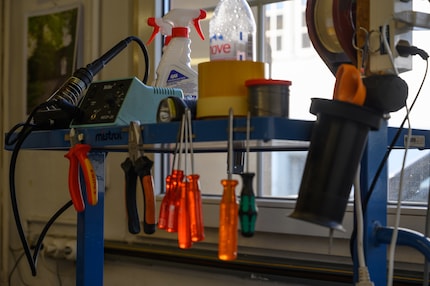
A large listening room on the left, where current models are on display. There is no reception desk. But this is the right place for us.
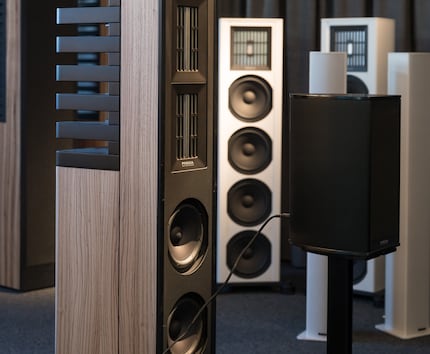
We are welcomed by Michael von Flüe from Sales. We are soon joined by Mario Ballabio, who will show us how loudspeakers are built at Piega. Ballabio's father worked at Piega until he retired - his son has now been with the company for 20 years. In addition to the guided tours, Ballabio works directly on the product: he manufactures the ribbons, a midrange and tweeter developed by Piega itself. The company's trademark and unique selling point. Ballabio has produced 12,000 of these by hand.
Possibly also the ones in my speakers. I have to say that briefly at this point: I myself am a staunch Piega customer. I have owned speakers from Horgen for over ten years. So I'm all the more excited to find out in person today how the speakers I love so much are made. What I'm most looking forward to is being able to listen to the really big speakers. The priceless flagships that are powered by wickedly expensive electronics.
The tour begins and Mario guides us through the premises. At the previously deserted workstation, an employee is soldering together the electronics for a subwoofer. Right next to it, the small version of the ribbon tweeter is being assembled.
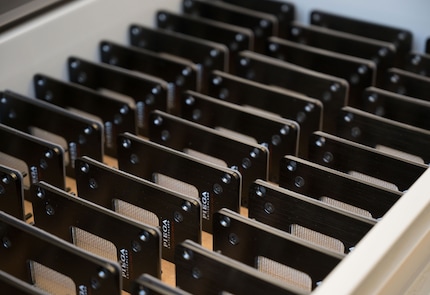
A few steps further on is the repair station. I ask Roger Strebel what there is to mend. "It's not usually defects," he explains. Sometimes children have stuffed CDs and coloured pencils into the bass reflex opening. Only rarely does the ribbon have to be replaced at great expense because the wafer-thin film has been touched or damaged, says Strebel.
We continue to the upper floor. My heart skips a beat when I discover empty housings of the "Master Line Source" dipole loudspeaker. I've never had the chance to listen to the top model before.
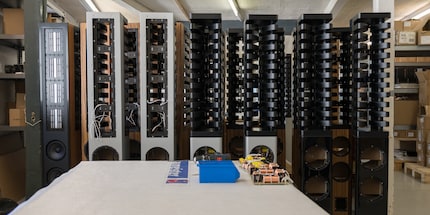
A few steps further on, Ballabio shows us the characteristic aluminium enclosures used in the Premium series. The enclosures are pressed out of a block of aluminium weighing several tonnes, like a giant macaroni. This means they are made from a single mould and are very rigid. "You can count the number of pressing plants in Europe that can do this on one hand." Stiffness and insulation are the most important things in a speaker enclosure. "It's exactly the opposite of a violin, where the body acts as a resonance chamber." An ideal cabinet is infinitely rigid and has infinitely little natural vibration, he explains.
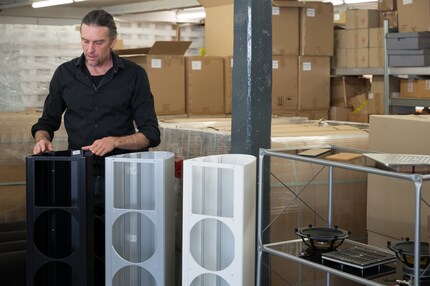
We move on to the last station, where the large coaxial ribbons - which also contain a midrange driver in addition to the tweeter - are assembled by hand. It takes years of experience and a great deal of sensitivity, says Ballabio. It takes him around four hours per piece. Once everything has been glued together, the large ribbons remain in the vice for 48 hours.
There are various individual parts for ribbons on the table. They all look the same to me. "Here we experimented with which glue to use to glue the neodymium magnets to the base plate," explains Ballabio. He holds up the first piece and taps it. It has a dull reverberation. The second piece only makes a dry "tock" sound. "The soft glue produces a better sound," says Ballabio. "Unfortunately, it wasn't strong enough and the magnets came loose. That's why we had to compromise on the glue, but we dampened the front panel with rubber."
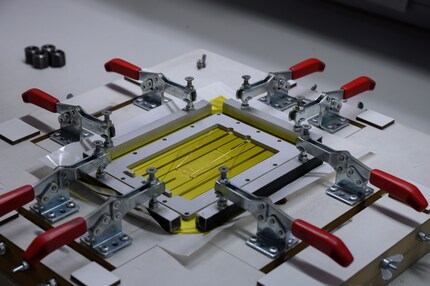
This concludes the tour. We make our way back to the listening room. This time I pay more attention to the rooms. Boxes of components everywhere. Soldering irons. They're even tinkering with the right glue mix. A manufactory where the term is not meant as Marketing. "They're nerds," I think.
The very first loudspeaker built by founders Leo Greiner and Kurt Scheuch over thirty years ago already contained a ribbon. The idea was to replace the widely used dome tweeter with something better: An extremely lightweight transducer that reacts quickly to impulses, ensuring very precise and clear reproduction, especially in the treble range.
The functional principle of this so-called magnetostat was invented decades ago. It has not caught on in the mass market because, unlike the simpler dome design, it is very complex and expensive to manufacture. Piega took the idea and perfected it. The coaxial ribbon, which also covers the mid-range, is unique in the world.
A half-assembled example of a coaxial transducer stands on the table in the listening room: a plate with magnetic rods on the left, the aluminium foil in the middle and another plate with magnets on the right.
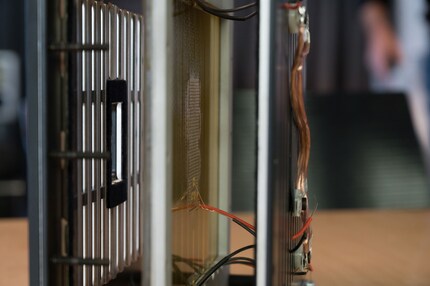
Piega has made a name for itself internationally over the last few decades and won a number of industry awards. The Swiss speakers are particularly popular in Germany, Scandinavia, the Benelux countries and Japan.
This is despite the fact that the elaborately manufactured speakers come at a price. Just to give you an idea: The most expensive model, the "Master Line Source", has a list price of 195,000 francs. It took several years to develop because Piega had to realise the principle of Linienschallquelle ("Line Source"). Annual sales can probably be counted on one hand. What does the company do for a living?
The first reason is that Piega also produces more affordable models that are intended to appeal to beginners. The second reason is that hi-fi enthusiasts are prepared to pay the high prices for these speakers. Here is an anecdote from the Piega forum: A customer reports a conflict with his girlfriend. She wants to put flower pots on the speakers, which the audiophile vehemently wants to prevent. When asked about the problem some time later, he says: "I'm single now."
Finally, the show starts! First, we get to listen to the new "Premium Wireless" speakers, which were launched on 5 April. They are the first wireless speakers from Piega. They connect automatically to a speaker, the wireless connection is proprietary and lossless. Anything that delivers music can be connected to the speaker: An amplifier, an MP3 player or a streaming service. The Premium Wireless speakers are active speakers, so they have their own amplifier in the speaker housing. They sound really great and I'm amazed at what the small bookshelf speakers are capable of.
After that, Ballabio presents a pair of TMicro 60 AMT, a comparatively inexpensive speaker that we have in our range. The small TMicro 60s do not have a ribbon, but an air motion transformer (AMT), which is not handcrafted in Horgen. The principle is related to the ribbon. Doesn't sound quite as great as the large coaxial ribbons, but still very precise.
As the crowning glory, we can then listen to the "Master Line Source 3" presented last October. Non-binding retail price: 35,000 francs per pair. Finally, the setup with the T+A system, which costs around 100,000 francs, makes sense. I'm as happy as a snow king.
After Mario has played a few tracks - streamed via Tidal, by the way - he hands the iPad to the guests. (David and I are joined by my boss and two employees from the purchasing department). We don't get out of the listening room for much longer because everyone wants to try out a track.
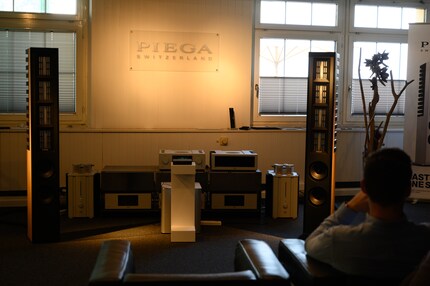
I'm pretty spoilt by my hi-fi setup at home. The "Master Line Source 3" still blows me away. Goosebumps! Inwardly, I curse the brutes from Horgen. Do I need to upgrade? This report could cost me more than I thought.
In digitec's range you will only find the Micro and Classic series from Piega with AMT. The "big" speakers with tweeter ribbon or coaxial ribbon are reserved for specialist retailers. Of course, we at digitec would prefer to have all models in our range, but on the other hand - you don't buy speakers costing tens of thousands of francs without having tested them thoroughly first. And it's fair to buy them where you've been allowed to test them.
Apropos test listening: In consultation with Piega, we can offer some customers the chance to see the factory in Horgen in person. On Saturday, 18 May at 09:30 in Horgen (ZH). The tour will last about two hours. Are you interested? Then register in the form below.
Update: The tour on Saturday 18 May in the morning is unfortunately fully booked. Due to the high demand, we have been able to arrange three further viewing dates with Piega on 18 May and 19 May. Big request: Please only register if you can actually attend the relevant date. Registration does not guarantee an invitation. We will inform you in good time by e-mail whether it has worked out.
I would like to register bindingly for the visit of Piega SA on Saturday 18 May at 13:30 in Horgen (ZH).
The competition has ended.
Here you can find all the Piega speakers we carry
I'm the master tamer at the flea circus that is the editorial team, a nine-to-five writer and 24/7 dad. Technology, computers and hi-fi make me tick. On top of that, I’m a rain-or-shine cyclist and generally in a good mood.
Interesting facts about products, behind-the-scenes looks at manufacturers and deep-dives on interesting people.
Show all